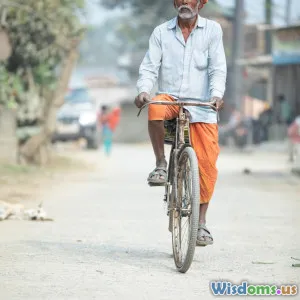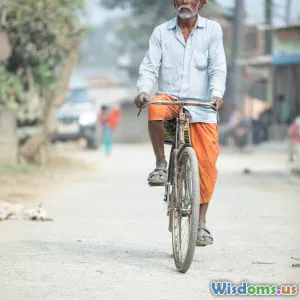
10 Common Myths About Solo Female Travel Debunked
8 min read Debunking 10 myths about solo female travel, empowering women to explore the world confidently and safely. (0 Reviews)
10 Common Myths About Solo Female Travel Debunked
Traveling solo is an empowering adventure, especially for women stepping out on their own for the first time. However, solo female travel has historically been entangled in myths and misconceptions that often discourage women from exploring the world independently. These myths sometimes stem from outdated stereotypes or misinformation rather than facts. In this article, we’ll confront and bust 10 prevalent myths about solo female travel, offering a fresh and reassuring perspective rooted in real-world experiences and expert insights.
Myth 1: Solo Female Travel Is Too Dangerous
Many assume that solo female travelers face insurmountable risks. While safety is a valid concern, it's important to differentiate perceived dangers from real ones. According to a 2020 survey by Hostelworld, 73% of solo female travelers reported that their trips improved their confidence with no significant safety incidents. Common sense, research, and vigilance go a long way. Countries like Japan, New Zealand, and Canada are repeatedly acknowledged as safe and welcoming spots for solo women.
Example: Sarah, a solo traveler from the UK, safely toured Japan independently for a month and shared, “The locals were helpful, and I never felt unsafe. Planning ahead and trusting my instincts made all the difference.”
Myth 2: Female Solo Travelers Are Lonely
Another misconception is the romanticized loneliness of solo travel. In reality, traveling alone doesn't mean being isolated. Solo travelers often enjoy meeting locals and other travelers, creating spontaneous friendships and unforgettable memories.
A 2019 Lonely Planet survey found that 82% of solo travelers felt more connected to people worldwide. Hostels, group tours, and social apps foster rich social experiences even when traveling solo.
Insight: Solo doesn’t mean solitary; it often means more freedom to connect on one’s own terms.
Myth 3: Solo Female Travelers Can't Navigate Certain Cultures
Many believe cultural norms in some countries restrict solo female travel. While cultural sensitivity is necessary, many women travel successfully in countries with diverse cultural expectations. For instance, travelers navigate dress codes, social customs, and etiquette respectfully and receive warm hospitality in return.
Case Study: In Morocco, traveler Emily adapted by dressing modestly and engaging openly with locals, reporting a deeply enriching experience that challenged her preconceptions.
Myth 4: Solo Female Travel Is Expensive
Travel costs vary widely but traveling solo doesn’t inherently mean more expense. Budget-careful travelers leverage hostels, budget airlines, local eateries, and off-season deals to travel economically.
According to Nomadic Matt, solo travel budgets can be comparable or even lower as solo travelers avoid commitments and flexibly alter plans to save money. For example, a solo traveler can opt out of group tours, which may have a premium price.
Myth 5: Women Need to Compromise Their Safety by Staying in Men-Only Groups or With Locals
Many myths wrongly suggest women must stay in men-only environments or with locals to stay safe. In reality, solo female travelers stay in female-only dorms, female-friendly accommodations, and women’s guesthouses designed specifically to enhance safety and comfort.
Platforms like Airbnb now feature verified women hosts with high safety ratings, increasing options for safe female solo stays.
Myth 6: You Must Be Younger or Single to Enjoy Solo Female Travel
Solo adventures aren’t limited to youth or single women. Women of all ages and marital statuses travel solo successfully. According to the Adventure Travel Trade Association, the number of solo female travelers over 50 increased by 34% between 2017 and 2021.
Example: Joan, a 62-year-old retiree, describes solo travel as “liberating,” enabling personal growth and lifelong learning.
Myth 7: Solo Female Travel Issues Only Stem From Stranger Danger
Safety concerns often focus on strangers, but many risks come from broader travel factors: traffic accidents, health issues, or bureaucratic challenges. Proper preparation such as travel insurance, local emergency knowledge, and health precautions play pivotal roles.
Being aware and equipped with reliable resources is far more effective than fearing strangers alone.
Myth 8: Women Can’t Travel Alone in Certain Countries
While political and cultural climates can vary, many women successfully travel solo to countries perceived as restrictive like India, Egypt, and Mexico. Success here hinges on creating smart itineraries, connecting with trusted guides, and maintaining awareness.
Numerous blogs and communities provide indigenous knowledge and seasoned tips, turning challenges into powerful travel stories.
Myth 9: You Need to Speak the Local Language To Travel Solo
Though knowing the local language helps, it’s far from a requirement. English often serves as a global travel lingua franca, and technology like translation apps bridges language gaps effectively.
Solo travelers routinely thrive by using simple communication tools and the universal language of kindness and gestures.
Myth 10: Solo Female Travel Limits Safety to Only Women-Friendly Destinations
While some women prefer women-focused tours or destinations, limiting travel only to well-known “women-friendly” spots restricts world exposure. Many solo female travelers navigate diverse destinations by doing due diligence and tailoring travel patterns accordingly.
Notably, traveling in less-touristy places can yield memorable cultural immersion and fewer crowds, qualities many solo travelers seek.
Conclusion: Empowerment Through Myth-Busting
Myths about solo female travel persist but often for reasons disconnected from the evolving realities of global travel. By debunking these myths with facts and personal stories, the narrative around solo female adventures is shifting toward empowerment, confidence, and optimism.
The world is vast, varied, and welcoming to solo female travelers who prepare wisely and embrace adventure on their own terms. As the famous traveler Freya Stark once said, “To awaken quite alone in a strange town is one of the pleasantest sensations in the world.”
Whether you are contemplating your first solo trip or a seasoned traveler, let these myth-busting perspectives encourage you to explore boldly and safely, cultivating unforgettable experiences worldwide.
Embrace solo travel. Dispel fears with knowledge. Explore the extraordinary you.
Rate the Post
User Reviews
Popular Posts




















